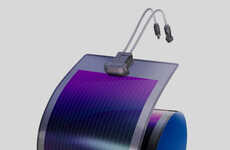
This Inexpensive and Ultra-Thin Technology is Great for Developing Countries
Meghan Young — June 21, 2015 — Eco
References: mymodernmet
These printed solar cells are already making a big impact on the world. Less expensive to produce than more traditional solar cells, they are great for developed nations whose citizens want to decrease their carbon footprint and, more importantly, those living in developing countries. The paper-thin and flexible solar cells require only an industrial printer to manufacture.
A great tool to help fight poverty, Scott Watkins of Korean firm Kyung-In Synthetic says, "I’ve witnessed first-hand how the technology has enabled urban poor communities in India to access off-grid electricity. Its success is due to its cost effectiveness and simplicity. A 10×10 cm solar cell film is enough to generate as much as 10-50 watts per square meter.” Granted, there are still some obstacles that needs to be worked out before they can truly make a difference.
A great tool to help fight poverty, Scott Watkins of Korean firm Kyung-In Synthetic says, "I’ve witnessed first-hand how the technology has enabled urban poor communities in India to access off-grid electricity. Its success is due to its cost effectiveness and simplicity. A 10×10 cm solar cell film is enough to generate as much as 10-50 watts per square meter.” Granted, there are still some obstacles that needs to be worked out before they can truly make a difference.
Trend Themes
1. Printed Solar Cells - The use of printed solar cells is a disruptive innovation opportunity that allows for cost-effective and easy access to off-grid electricity in developing countries.
2. Inexpensive Production - The trend of producing solar cells using inexpensive methods creates disruptive innovation opportunities for lowering the cost of renewable energy solutions.
3. Flexible Solar Cells - The development of flexible solar cells opens up disruptive innovation opportunities for creating lightweight and portable renewable energy solutions for various applications.
Industry Implications
1. Renewable Energy - The renewable energy industry can seize the opportunity of printed solar cells to revolutionize access to affordable and sustainable energy sources.
2. Manufacturing - The manufacturing industry can explore the use of industrial printers for producing printed solar cells, transforming the way solar panels are manufactured.
3. International Development - The international development industry can leverage printed solar cells to promote energy access in developing countries and drive socioeconomic progress.
6.2
Score
Popularity
Activity
Freshness























